The northern pintail is a large dabbling duck with a wide geographical distribution. It occurs throughout the northern regions of Europe, North America, the Middle East and the Palearctic.
The northern pintail is a highly adaptable bird that has colonized various habitats, including open water and wet grasslands. Consequently, the northern pintail has one of the most extensive ranges of all duck species.
The population of northern pintails has declined in recent years due to habitat loss and hunting pressure. However, it is still a common bird and is not considered endangered.
Scientific Name: Anas acuta
Wingspan: 80–95 cm (31–37 in)
Height:
- Male: 59–76 cm (23–30 in)
- Female: 51–64 cm (20–25 in)
Weight:
- Male: 450–1,360 g (0.99–3.00 lb)
- Female: 454–1,135 g (1.001–2.502 lb)
Description
A breeding male northern pintail duck is a stunningly beautiful bird. It has a chocolate brown head with a glossy sheen and iridescent feathers that shimmer in the light. Its white breast is accented by its long tail feathers, which fan out behind it when in flight, creating an impressive display.
It has a mostly gray body, with some areas having a slightly darker tone along the back and wings. It has a long neck that is also graced with a white stripe down the sides, adding to its regal appearance.
Its large webbed feet and wingspan make it an agile flyer that can soar effortlessly across vast distances when migrating season arrives.
An adult female northern pintail has an elegant appearance. It has a slender, streamlined body shape and is known for its distinctive long tail and lengthy neck. Its head is usually plain tan, with a small green patch of feathers just above the bill.
The rest of its plumage is a rich rufous-brown color, which appears to almost shimmer in the sunlight. The breast and wings are barred with lighter shades of brown, while its back and belly are more uniform. It also has a white line on the edge of its wings.
Large white patches can be seen on both sides of the rump. The head, neck, and chest have a more speckled pattern.
Females possess an elegantly curved bill that tapers off to a sharp point at the tip. The legs and feet are dark grayish-brown in hue.
Juveniles, non-breeding males and males in eclipse plumage have a paler appearance overall.
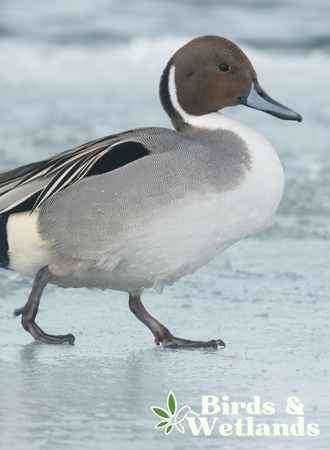
Listen to Northern Pintail
Habitat & Range
The northern pintail is a highly adaptable waterfowl species found in various open habitats. During the breeding season, they prefer open areas with relatively short vegetation, wet meadows, grasslands, seasonal wetlands and flooded fields.
In the non-breeding season, their preferred habitat shifts to flooded and dry agricultural fields, lakes, reservoirs, estuaries, brackish marshes, freshwater and exposed mudflats and bays.
The northern pintail uses its ability to switch between habitats to optimize its feeding opportunities quickly. It also needs fresh water to keep its plumage healthy and waterproof, as well as an ample supply of vegetation for shelter from predators.
In North America, a breeding population occurs in Alaska, far north as the Northwest Territories of Canada and the central United States. These birds winter in the Central Valley of California, but some flocks may fly further south into northern Mexico.
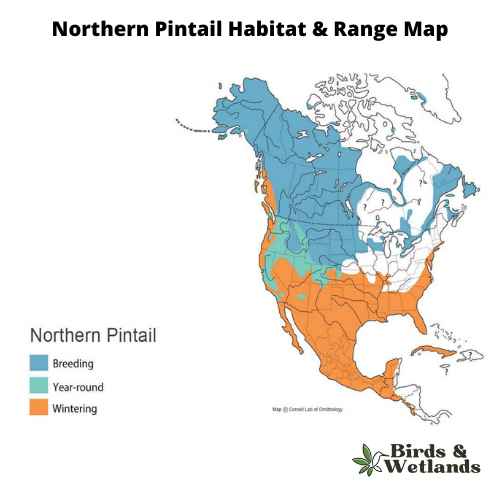
Migration
The northern pintail is a duck known for its impressive migration patterns. Northward migration begins early, usually in late February or early March. During this time, these common birds travel far and wide in flocks from their wintering grounds to their breeding grounds up north where continuous daylight allow for 24/7 feeding.
As the autumn months approach, they switch their course and migrate southward. This journey lasts for much of the fall and often leads them across the Bering Strait into North America.
As with many waterfowl species, the northern pintail is a social creature that loves company during its travels. It is not uncommon to observe large flocks with other ducks numbering into the thousands as they make their way from one place to another each season.
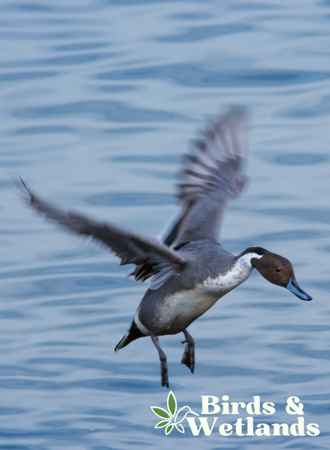
Diet & Food Habits
The Northern Pintail is a highly versatile feeder, utilizing both animal and plant matter depending on the season.
When breeding in the spring and summer, these dabbling ducks primarily consume aquatic invertebrates such as aquatic insects, mollusks, crustaceans, amphibians, and occasionally small fish.
During the winter, their diet consists primarily of seeds from aquatic plants, with only 10% of their diet consisting of animal matter, such as dead insects.
The Northern Pintail can be observed searching for food in shallow waters or wet meadows. They seek waste grain, tubers and other parts of aquatic plants, such as sedges, which provide them with ample energy during the colder months when food sources are scarce.
The unique ability of the Northern Pintail to use its bill as tweezers enables it to extract seeds from mudflats or submerged vegetation that would be inaccessible to other birds. This allows them to feed in shallow water areas where larger species cannot reach food due to their size.
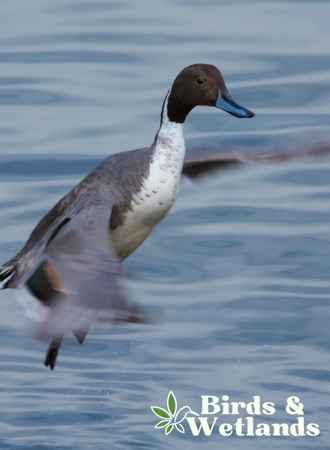
Behavior, Nesting & Mating Habits
Northern pintails for pairs during the winter and spring migration. They tend to lay their eggs in sparse vegetation near seasonal and semi-permanent wetlands in prairie and tundra habitats. These birds mate in early May.
During breeding, females choose the nest site and usually build their nests far from the water’s edge, often hidden in dense vegetation. The nests are typically cup-shaped or have a shallow depression on the ground. It is made from soft plant material such as leaves and grass and lined with down and breast feathers.
Farming operations may destroy some nests, especially when built near or in farm fields.
On average, a female northern pintail will lay 7 to 9 all-white eggs in her nest. Interestingly, she will replace the clutch if predators destroy her eggs. She incubates the eggs alone, without the help of the male, between 21 to 25 days. Some males stay close to the nesting area during incubation and protect against predators.
A few hours after hatching, females lead their young to the nearest body of water while swimming close to them. They take care of the ducklings, and only three-quarters fledge approximately 40 to 45 days later. Not more than half of the remaining birds survive long enough to reproduce.
These birds become very wary and secretive during the flightless stage in late summer.
Population & Conservation Status
Northern pintails are a large, dabbling duck species with a global population estimated at around 5 million individuals. While this number has been relatively stable in recent decades, the trend has been downwards due to various pressure factors, most notably climate change, habitat loss and hunting.
However, the International Union for Conservation of Nature (IUCN) still maintains a conservation status of least concern, indicating their strong overall populations.
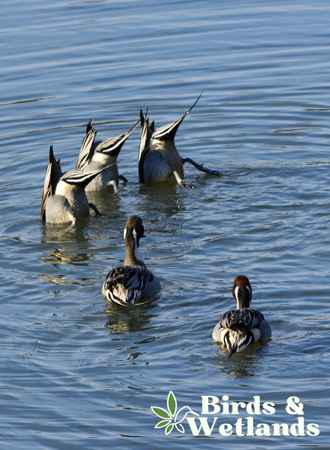
Hunting
Hunting of northern pintails is allowed in most states where they occur. It is subject to federal and state regulations and limits.
Key Points
- Male northern pintails are long-necked ducks with a dark brown head and pointed tail feathers when breeding plumage.
- Many northern pintails nest away on dry ground, away from the water.
- Pintails are among the most numerous species around the world.

